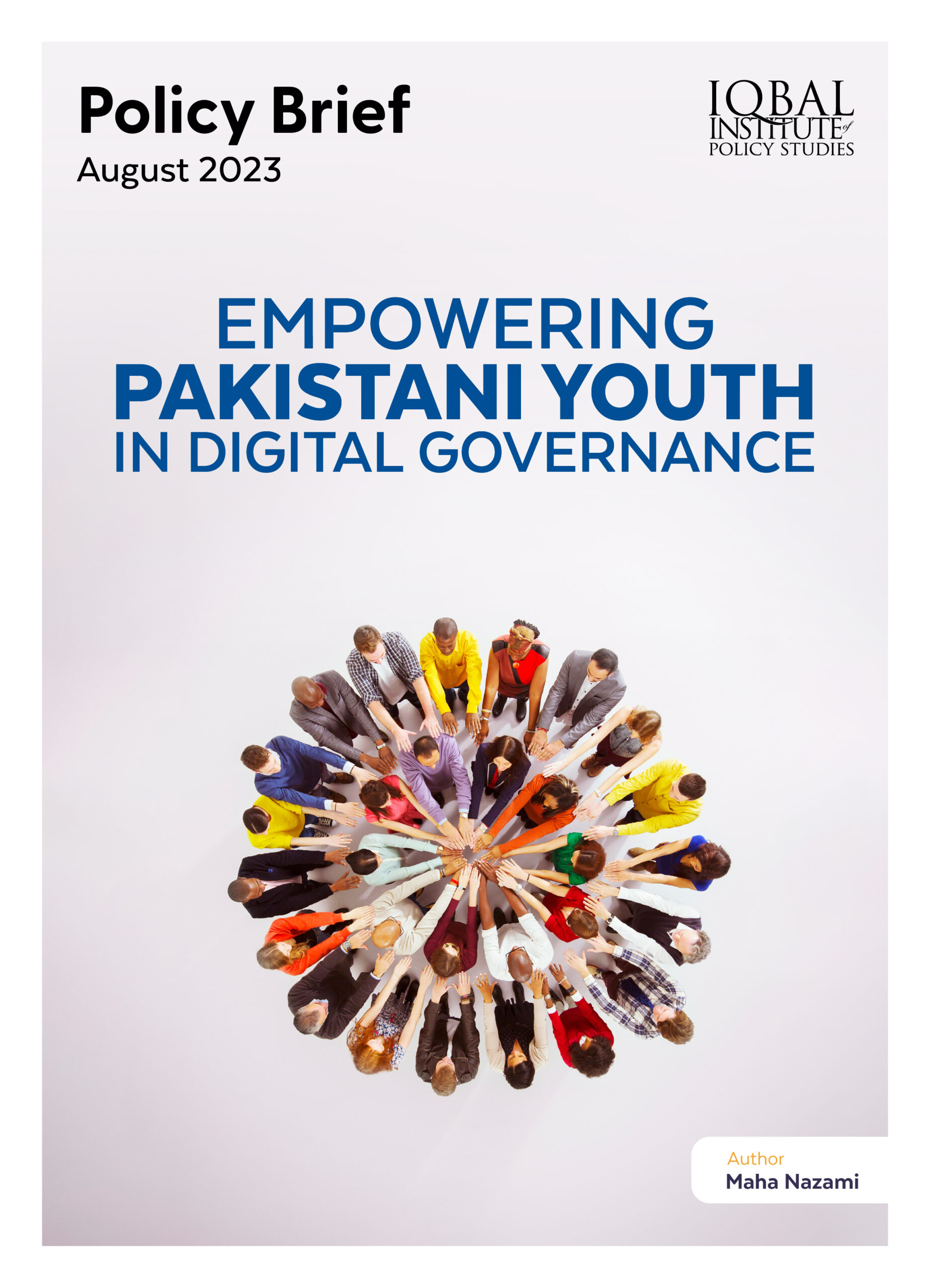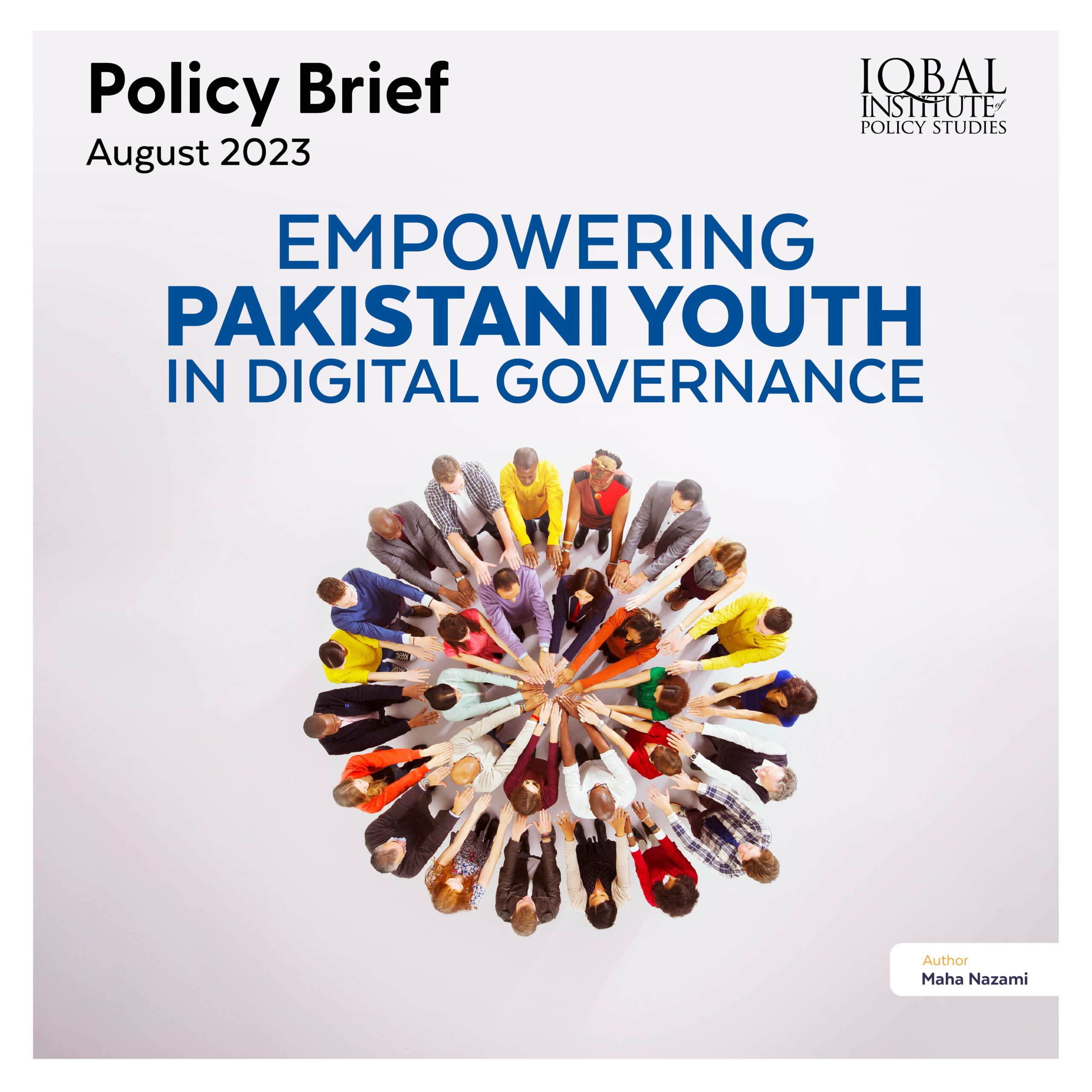Youth participation is crucial for fostering a dynamic, inclusive, and democratic society. In Pakistan, a country with a significant youth population, harnessing the potential of young people in decision-making processes and public service is essential for sustainable development. Digital technologies offer a transformative avenue to engage youth in these domains, enabling their voices to be heard, promoting transparency, and enhancing the efficiency of public services. This policy brief outlines recommendations to promote youth participation in decision-making and public service through digital technologies in Pakistan.
Current Situation
Globally, the standard age for eligibility for national parliamentary elections typically commences at 25 years old. According to a 2012 Global Parliamentary Report by the UNDP, around 1.65 percent of parliamentarians worldwide are in their twenties, while 11.87 percent fall within their thirties.
In Pakistan, the youth make up a substantial 60 percent of the total population, yet their representation in the political system remains notably scarce. This youth population is not only a wellspring of innovation and ingenuity but has also played a significant role in driving pivotal changes within political frameworks, power-sharing dynamics, and economic prospects since the inception of Pakistan. The Youth Parliament of Pakistan, established in 2007, has emerged as a major catalyst for these transformative shifts, serving as a platform to engage young individuals in dialogues concerning critical issues impacting the nation. Concurrently, at the local governance level, youth are actively participating in driving the execution of initiatives. In a recent instance, during the local government elections in Khyber Pakhtunkhwa Province, 3,339 seats were specifically allocated for youth candidates.
Pakistan stands as a democratic nation where each citizen possesses the right to education, a reasonable standard of living, and the ability to elect and influence political leadership. Within the context of this assertion, youth are entitled to an equitable right to political engagement on par with other age groups. National legislation empowers youth aged 18 years and above to exercise their voting rights during elections.
“Meaningful youth participation involves recognizing and nurturing the strengths, interests, and abilities of young people through the provision of real opportunities for youth to become involved in decisions that affect them at individual and systemic levels.”
– The Canadian Mental Health Association (CMHA)
Challenges
- Limited Access to Digital Technologies:
The challenge of unequal access to digital technologies poses a significant barrier to promoting youth participation in decision-making and public service. While urban areas often have better internet connectivity, rural and marginalized communities lack reliable and affordable internet access. This digital divide can exclude a substantial portion of the youth population from engaging in online platforms and initiatives.
- Digital Literacy Gap:
The digital literacy gap remains a considerable obstacle, preventing many young people from effectively utilizing digital platforms. While youth may have access to technology, a lack of essential digital skills can hinder their ability to navigate online spaces, engage with digital tools, and comprehend complex platforms.
- 3. Lack of Awareness and Engagement:
Despite the potential of digital technologies, many youth may be unaware of their rights, responsibilities, and opportunities for participation. Moreover, even if they are aware, there might be a lack of motivation or engagement due to skepticism about the impact of their involvement or mistrust in the effectiveness of digital platforms.
- 4. Inclusivity and Gender Disparities:
Gender disparities can further compound the challenge of youth participation. Cultural norms and societal biases may restrict the involvement of young women in digital spaces, leading to a skewed representation. Addressing these disparities and ensuring the inclusion of marginalized and underrepresented groups becomes crucial for creating an equitable digital participation landscape.
- Limited Access to Information:
Many young people may lack access to accurate and up-to-date information about political processes, public services, and governance. This information gap can hinder their ability to make informed decisions and engage effectively in discussions on digital platforms.
- 6. Privacy and Online Harassment Concerns:
Youth, especially young women, may hesitate to participate in digital spaces due to concerns about online harassment, privacy breaches, and security risks. Ensuring a safe and respectful online environment becomes paramount to encourage meaningful participation.
- Political Apathy and Skepticism:
A significant challenge is countering the prevailing sense of political apathy and skepticism among the youth. Many young people may feel disconnected from traditional political processes and doubt the efficacy of their engagement through digital means.
- Resource Constraints:
Initiatives promoting youth participation through digital technologies require resources for development, maintenance, and outreach. The challenge lies in allocating adequate resources and securing funding to sustain these initiatives over the long term.
Navigating these challenges requires tailored approaches that consider the unique needs, circumstances, and aspirations of the youth population in Pakistan. By addressing these obstacles, policymakers and stakeholders can create an environment that empowers Pakistani youth to actively engage in decision-making and contribute to public services through digital platforms.
Recommendations
- Digital Infrastructure Enhancement:
– Expand Connectivity: Increase investment in digital infrastructure to ensure that all regions have access to reliable and affordable internet services.
– Digital Literacy Programs: To bridge the digital literacy gap, invest in comprehensive digital literacy programs that equip youth with essential skills to navigate digital platforms confidently and effectively. Collaborate with educational institutions, community centers, and NGOs to offer training sessions on effectively using digital tools and platforms.
- Youth-Centric Digital Platforms:
– Mobile Apps and Portals: Develop user-friendly mobile applications and online portals tailored to the needs and preferences of Pakistani youth. Ensure these platforms are intuitive, easily navigable, and designed with the diverse literacy levels and linguistic backgrounds of the youth population in mind.
– Interactive Platforms: Develop platforms that enable youth to provide feedback, propose ideas, and contribute to policy discussions in an engaging manner.
- Public Awareness Campaigns:
– Information Dissemination: Launch awareness campaigns to educate youth about their rights, responsibilities, and available opportunities for participation through digital technologies.
– Cultural Sensitivity: Tailor campaigns to address cultural norms and challenges faced by marginalized youth, encouraging their active involvement.
- Capacity Building:
– Digital Skills Training: Collaborate with educational institutions and NGOs to offer digital skills training to youth, empowering them to use technology effectively.
– Civic Education: Integrate civic education into school curricula to foster an understanding of democratic processes and responsibilities from a young age.
- Inclusive Engagement:
– Gender-Sensitive Approaches: Implement strategies to ensure equal participation of young women in digital platforms, addressing barriers such as online harassment and privacy concerns. Promote digital safety, and create safe spaces for diverse voices to be heard. Engage women leaders and role models to inspire and guide young women in their online engagement.
– Representation of Marginalized Youth: Ensure that the voices of marginalized and underrepresented youth are heard through targeted outreach and support.
- Open Data and Transparency:
– Open Government Data: Publish government data in open formats to enhance transparency, enabling youth to access information and monitor public services.
Feedback Mechanisms: Establish digital channels for youth to provide feedback on public services, fostering accountability and responsiveness.
Implementation Strategy
- Collaborate with telecommunications providers to expand internet coverage in underserved areas.
- Partner with technology companies and NGOs to develop user-friendly digital platforms.
- Collaborate with schools and universities to integrate digital literacy and civic education into curricula.
- Conduct workshops and training sessions for youth on using digital platforms for engagement.
- Engage with youth-led organizations and community leaders to ensure inclusivity in digital initiatives.
- Establish government task forces or committees to oversee the implementation and evaluation of digital engagement efforts.
Conclusion
Promoting youth participation through digital technologies is pivotal for creating an inclusive and responsive society in Pakistan. By addressing challenges related to access, digital literacy, awareness, and inclusivity, the country can unlock the immense potential of its youth population in shaping decisions and improving public services. Through strategic implementation and collaboration, Pakistan can pave the way for a brighter future, where young people are active contributors to sustainable development and nation-building.



Leave a Reply